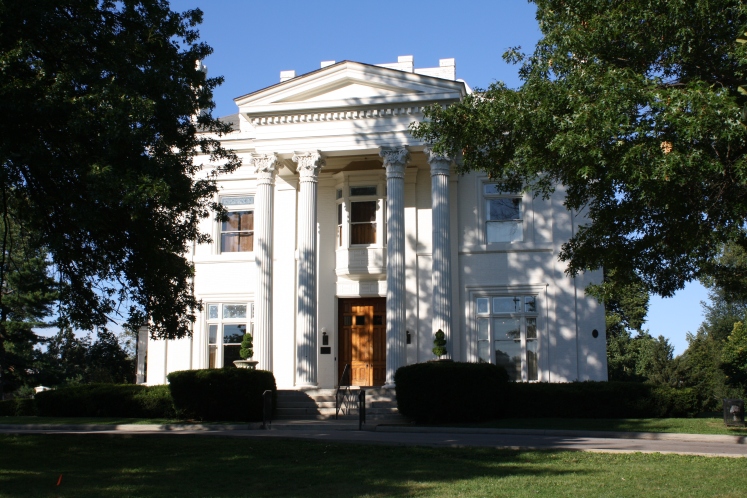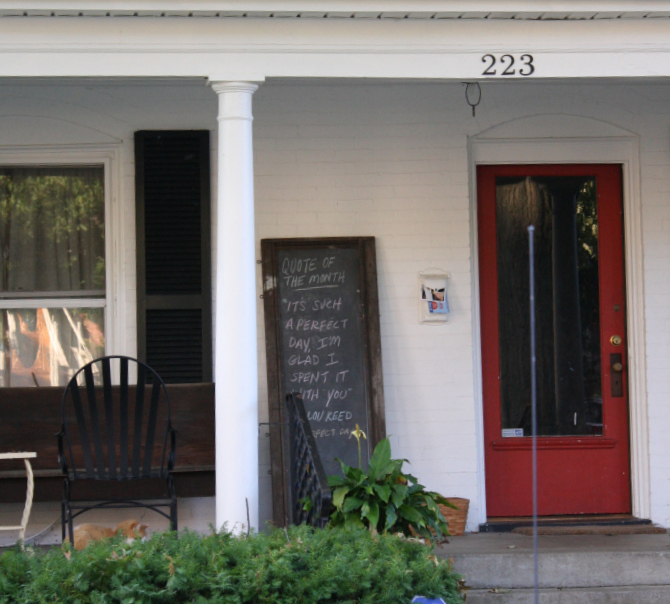Tagged: Clara Bell Walsh
deTour to Manhattan Society Queen’s Court
Mrs. Clara Bell Walsh (1884-1957), once described by a newspaper as, “the famed Clara Bell of Kentucky, who knows more about horses than any other woman in America and so much about society that society wishes she would be stricken with a loss of memory,” has many claims to fame.
She was the first resident of the Plaza Hotel in New York City. She is nvented the cocktail party. She had an elephant at the St. Louis Zoo named after her. (Don’t worry, it wasn’t a slight – she was very fond of elephants.) And she rubbed elbows with movies stars and politicians.

Bell Place and its park like setting at the center of the Bell Court neighborhood in Lexington, KY was once the home to millionaire socialite, Clara Bell Walsh.
Her cosmopolitan and colorful life began in Lexington, Kentucky. The only child of businessman D.D. Bell, she was born into luxury. Their home, Bell Place, was one of Lexington’s largest residences. It was built upon the foundation of her grandfather’s Greek Revival mansion, Woodside, just outside of downtown. After her father died, she inherited a sizable trust fund that included Bell Place and its surrounding acreage. By the time Clara took control of her trust at just 21, she was a very, very wealthy young woman – in part because the property around Bell Place had been subdivided into the Bell Court neighborhood. Later, Clara and her mother gifted the house to the city of Lexington. Today, it is Lexington’s Parks and Recs department and its carriage house is home to the Studio Players, Kentucky’s oldest community-involved theater!
Bell Place (1884)
Bell Place, Clara’s childhood home, is large and handsome. Though its exterior has an eclectic mix of decorative elements, a strong Greek Revival theme unites them. The result is not the overly-wrought and effusive nature of some Victorian design. It is classically elegant. The strong Greek Revival influence was inspired by Woodside, the Greek Revival mansion (ca. 1854) of Clara’s grandfather, Henry, which stood on the site before it was destroyed by fire.
Henry Bell began his career as a store clerk in Baltimore, and died one of the most influential and wealthiest men in Lexington after proving himself as a sound businessman and financier. His home, Woodside, was designed by an important Lexington architect, Maj. Thomas Lewinski. It was a showplace. Conveniently located just outside of downtown, it was a suburban social center where Lexington elites paid calls, attended gatherings and had parties. In 1848, Mary Todd Lincoln described Woodside to her husband, US Congressman Abraham Lincoln, in a letter. “…[R]ode out to Mr. Bell’s splendid place this afternoon to return a call. The house and grounds are magnificent,” she wrote.
After Henry’s death, Woodside passed to Clara’s father, D.D. Bell. Not long after Bell and his wife, Sydney Sayre Bell (daughter of David Sayre), moved into the house, Clara was born. Unfortunately, when she was only a few months old, it burned. The fire that destroyed Woodside started in a servant’s quarters where an unattended lamp exploded. Though the Lexington Fire Department worked to save the house, its rescue was doomed by a burst hose, the absence of the engine horses, and exhausting the water supply from Woodside’s three wells.
D.D. Bell hired Cincinnati architect Samuel Eugene Des Jardins to reconstruct the mansion. Des Jardin blended the classic proportions and decorative elements of Woodside with current design trends to create Bell Place. Surviving blue prints and the architect’s notes indicate that Des Jardins used some of Woodside’s surviving components in the new construction, as well. Some, if not all of Bell Place rests on Woodside’s foundation. Walls that were not damaged and fit the new configuration of the house were also maintained. Much of the brick that was not scorched or smoke damaged was also incorporated into the new structure. (The bricks, incidentally, were made entirely on site during the original construction of Woodside). Elements that were not salvaged from Woodside were dictated by the architect to be of the finest quality and were carefully chosen.
By 1884, Greek Revival architecture had fallen out of favor in preference of eclectic revivals of historic styles mixed with elements of middle east and Asian influences. The design of Bell Place reflects the trend, but is tempered by strong Greek Revival elements that mirrored the Bell’s beloved Woodside, particularly on the exterior. A good example of Des Jardins blend of Greek Revival and eclectic are the windows. As the National Register points out, they “have Victorian hoodmolds yet they are Greek Revival in appearance.” The triple windows on the facade are also Greek Revival, but the transoms are fashionable stained glass. Stained glass is featured in other windows, as well. The nursery designed for Clara has a triple window in the oriel with stained glass transoms depicting cupids- one learning numbers, one learning music and the other of a biblical motif!
Bell Place’s interior expresses the aesthetic movement more fully that it’s exterior. Interior decorations were profuse and opulent, having been carefully chosen for their quality and beauty. Interior finishes include Gothic, Queen Anne and Eastlake, Arabist, and Adams, as well as a Japanese influenced elements. (See photos).
The Carriage House to the rear of Bell Place was designed to have a Swiss Chalet effect – and was probably where Clara housed her award-winning pony, Fancy.
The Society Belle’s Court
D.D. Bell increased his suburban land-holdings with an eye to subdivide the property around his home after he observed electric trolleys spurring development at the edge of downtown. Though he died before implementing his plan, he left instructions for his wife to carry out the subdivision to provide income for Clara. His will also set up a trust for Clara that included Bell Place among other assets, such railroad stock and government bonds. By the time Clara was 15, she was worth over $600,000, not including Bell Place. That’s almost 2 million today!
In 1906, D.D.’s plans were finally implemented. The property around Bell place was subdivided into 134 lots, reserving 4 1/2 acres around the main house and its ancillary buildings. The sales substantially added to Clara’s net worth.
Bell Court quickly became a coveted neighborhood. It was near downtown, but was a “separate and quiet enclave defined by its physical boundaries and its neighborhood spirit.” The houses built on the property surrounding Bell Place are mostly cottages and bungalows with Arts and Crafts, Colonial Revival, and/or Dutch Colonial details. Architectural historian, Clay Lancaster, grew up in the neighborhood. In 1985, he recalled,
When I came from downtown, along Main Street, with its noise and smell of traffic, a great peace settled over me as I turned into the quiet of Bell Court. Many people walked, in those days, and people sat on their front porches in the late afternoons and evening, talking and visiting, while the children played together in the yard. Sometimes we could persuade my mother to perform on the piano in the living room, and some of us would sing. It was a friendly sociable atmosphere. People lived just close enough together and just far enough apart, and the neighborhood was agreeably cloaked in verdancy.
The Gift of Bell Place
On her 21st birthday, Clara Bell came into her fortune. The house and all of her assets transferred from her trust to her control. The same year, she married Julius Sylvester Walsh, Jr., son of one of St. Louis’ chief capitalists and railroad men. (Clara’s grandfather and father had established business ties in Missouri by 1860). The wedding took place at Bell Place.
Shortly after their wedding, Clara and Julius were among the first residents to move into the luxurious Plaza Hotel on Oct 1, 1907. There, they lived lavishly, dividing time between NYC, St. Louis and Europe. Trips to Lexington and Bell Place, which she gave to her mother for Christmas the year after she married, were also common.
Alas, despite her wealth and advantages in life, Clara’s marriage was not a happy one. In 1923, she shocked society by suing for divorce. Thereafter, she referred to her husband as deceased – she really wasn’t a woman to go in for subtlety!
After her divorce, she continued her busy social calendar, making The Plaza her main residence. And if anything, her lifestyle became even more lavish.
She was friends with the likes of Mae West, John Barrymore, Ethel Merman, Queen Mary, Gregory Peck, and Dwight Eisenhower – whom she entertained at The Plaza with small intimate gatherings of several hundred people.
The company she kept could sometimes be controversial, however. Ward Morehouse wrote that she was
“an early champion, in her own personal way, of human rights, inviting prominent blacks into her apartment at a time when they were barred even from entertaining downstairs. one of her best friends was Bill ‘Bojangles’ Robinson, the black tap dancer who rocketed to international fame. Nevertheless, his renown didn’t shield him from the racial profiling of his day. A security guard spotted him coming off the elevator on Walsh’s floor one time and immediately asked the entertainer what he was doing there. Whereupon Bojangles literally danced his explanation that he was visiting his friend Mrs. Walsh. Which was all the dumbfounded guard needed to know.”
Her extravagance and eccentricity also often set the public’s tongue wagging. When she traveled to Europe in 1933, she reserved round trip fair for her automobile and chauffeur. This was during the Depression! And speaking of her car, she was also noted for special lights mounted on her limousine that allowed her to park almost anywhere in Manhattan!
Bell Place Re-Gifted
In 1940, Clara and her mother gave Bell Place and its surrounding 4.5 acres to the city of Lexington (retaining life estate) as a memorial to D.D. Bell. Her mother died later that year, but the property remained in the control of Clara who eventually rented it to the Cumberland Corporation.
The estate finally passed into the hands of the city in 1957 when Clara Bell Walsh died at The Plaza at the age of ” 70-odd (‘none of your business’),” to quote her obituary in TIME Magazine, exactly 50 years after she moved into the hotel.
(A curious side note: a court order was issued in 1969 authorizing MIT to make a chemical analysis of her remains). She is buried in Lexington Cemetery.
Clara Bell’s Legacy

The Bell Court neighborhood is a tight knit community. They have had an active neighborhood association since the 1960s.
Though the cocktail party may be Clara Bell’s most lasting legacy, Bell Place and Bell Court are a close second. Though meant to be a monument to her father, her fame far outreached his – so much so that the house is often referred to as the Clara Bell Walsh House. The neighborhood, which is listed in the National Register of Historic Places, is almost entirely intact and continues to be a close-knit and active community. Currently, Bell Place houses the offices of the urban-county governments’ parks and recreation department. The ground floor is available to the general public for events, which means that brides are still saying “I do” there, just like Clara.
*Special thanks to Jim Birchfield for leading a very informative and entertaining walking tour of the Bell Court neighborhood, beginning at Bell Place. And for sharing his research on the family, house and neighborhood. Much of this post was culled from his efforts!*
The Blue Grass Trust’s deTours is a group of young professionals (and the young at heart). The program provides behind-the-scenes tours of historic buildings, places, and sites in central Kentucky. BGT deTours are free and open to the public. They occur on the first Wednesday of every month.






















